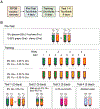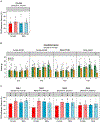The Effects of Roux-en-Y Gastric Bypass on Glucose- vs. Fructose-Associated Conditioned Flavor Preference
- PMID: 35149056
- PMCID: PMC8901435
- DOI: 10.1016/j.physbeh.2022.113730
The Effects of Roux-en-Y Gastric Bypass on Glucose- vs. Fructose-Associated Conditioned Flavor Preference
Abstract
In rodents, repeated single-bottle exposures to distinctly flavored isocaloric glucose and fructose solutions, two sugars with different metabolic pathways, eventually lead to a preference for the former. Because Roux-en-Y gastric bypass (RYGB) surgery decreases preference for and intake of sugar solutions in rats, we tested whether RYGB would curtail the conditioning of a preference for a glucose-paired vs. fructose-paired flavor. RYGB (♂ n=11; ♀ n=10) and sham-operated (SHAM; ♂ n=9; ♀ n=10) rats were trained with a single bottle (30 min/day) containing 8% glucose solution flavored with either 0.05% grape or cherry Kool-Aid (Glu/CSG) or 8% fructose solution with the alternative Kool-Aid flavor (Fru/CSF) in an alternating fashion for 8 days. To determine baseline preferences, a 4-day 30-min two-bottle test was used to assess preference for Glu/CSG vs. Fru/CSF before training. After training, 2-day 30-min two-bottle tests assessed preference for the a) Glu/CSG (CSG-flavored 8% glucose solution) vs Fru/CSF (CSF-flavored 8% fructose solution), b) CSG- vs. CSF-flavored mixture of 4% glucose & 4% fructose (isocaloric), c) CSG- vs. CSF-flavored 0.2% saccharin ("sweet", no calories), and d) CSG- vs. CSF-flavored water. During training, only male SHAM rats demonstrated progressively increased intake of Glu/CSG over Fru/CSF, and female SHAM rats displayed a trend. RYGB eliminated any difference in single-bottle intake of these solutions during training, regardless of sex. Like their male and female SHAM counterparts, male RYGB rats displayed a conditioned preference for the CSG-associated stimulus in Tests 1-3. Although female RYGB rats displayed acquisition of the conditioned flavor preference in Test 1, unlike the other groups, when the differential sugar cue between the two solutions was removed in Tests 2 and 3, female rats did not display a CSG preference. When the sugar and sweetener cues were both removed on Test 4, all groups displayed some generalization decrement. Thus, RYGB does not compromise the ability of rats to learn and express a glucose- vs. fructose-associated conditioned flavor preference when the exact CS used in training is presented in testing. The mechanistic basis for the sex difference in the effect of RYGB on the generalization decrement observed in this type of flavor preference learning warrants further study.
Keywords: Roux-en-Y gastric bypass; conditioned flavor preference; fructose; generalization decrement; glucose; sex difference.
Copyright © 2022 Elsevier Inc. All rights reserved.
Figures



Similar articles
-
Strain differences in sucrose- and fructose-conditioned flavor preferences in mice.Physiol Behav. 2012 Jan 18;105(2):451-9. doi: 10.1016/j.physbeh.2011.09.010. Epub 2011 Sep 14. Physiol Behav. 2012. PMID: 21945373 Free PMC article.
-
Conditioned flavor avoidance, preference, and indifference produced by intragastric infusions of galactose, glucose, and fructose in rats.Physiol Behav. 1999 Aug;67(2):227-34. doi: 10.1016/s0031-9384(99)00053-0. Physiol Behav. 1999. PMID: 10477054
-
Flavor preference conditioning by different sugars in sweet ageusic Trpm5 knockout mice.Physiol Behav. 2015 Mar 1;140:156-63. doi: 10.1016/j.physbeh.2014.12.027. Epub 2014 Dec 12. Physiol Behav. 2015. PMID: 25497884 Free PMC article.
-
Taste- and flavor-guided behaviors following Roux-en-Y gastric bypass in rodent models.Appetite. 2020 Mar 1;146:104422. doi: 10.1016/j.appet.2019.104422. Epub 2019 Aug 28. Appetite. 2020. PMID: 31472198 Review.
-
Dopamine and learned food preferences.Physiol Behav. 2011 Jul 25;104(1):64-8. doi: 10.1016/j.physbeh.2011.04.039. Epub 2011 May 1. Physiol Behav. 2011. PMID: 21549727 Free PMC article. Review.
References
Publication types
MeSH terms
Substances
Grants and funding
LinkOut - more resources
Full Text Sources
Research Materials

